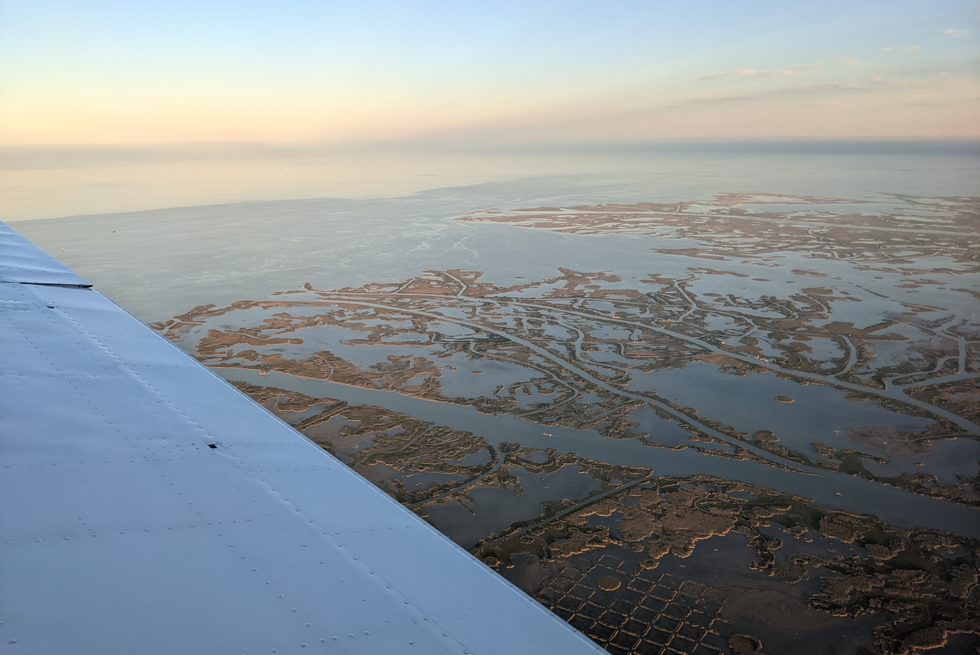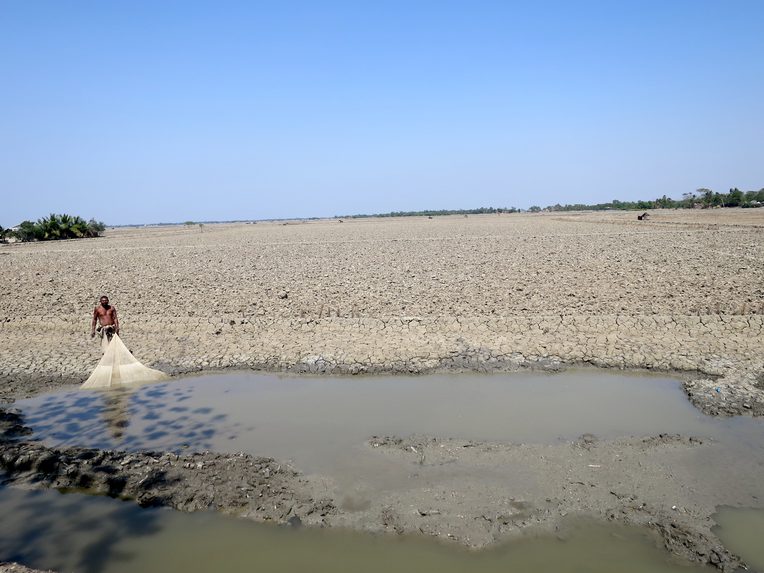Climate Reductive Translations of Salinity: Understanding Cyclone-Tiger Prawn Linkages in Bangladesh’s Southwest Coastal Zone
From the Series: Coastal Futures
From the Series: Coastal Futures

In 2014 and 2015, I conducted ethnographic fieldwork in an embanked floodplain, “Nodi” in southwest coastal Bangladesh. The Guardian article in Figure 1, suggesting brackish shrimp as a climate adaptation solution for Bangladesh, reflects a common line of argument pushed by capitalist tiger prawn–promoting actors throughout my time in Bangladesh and for over a decade.
For example, when I mentioned the 2008 grassroots movement that ended tiger prawn cultivation in northern Nodi, Mr. Jones, a Western development professional at a leading aquaculture research organization in Bangladesh, responded with the following:
Climate change is a fact. [All of] Bangladesh will become saline; it is inevitable. Bangladesh should accept this and focus on cultivating saline-tolerant species such as tiger prawn and [foreign] tilapia and export them. This is its comparative advantage. Why grow rice when Bangladesh can import rice from Myanmar? If you ask me, this is the future.
His words stunned me. Nodi is surrounded by rivers that are non-saline except for the dry season, from January to June. Salinity in Nodi is not permanent or inevitable; it is linked to the use of flood-protection embankments constructed in the 1960s and 1970s (Dewan 2021). From mid-March to mid-June, the salinity levels in the rivers are at their highest. The freshwater that fills the rivers during the monsoon recedes during this time and is unable to stop salt tidewater from creeping upward from the Bay of Bengal, while canals and domestic ponds slowly dry up. In this saline season, tiger-prawn cultivators open the embankment sluice gates during high tide to bring in salt tidewater for their shrimp farms. The tidewater penetrates the soil and makes it dry and less fertile and ultimately end up in cracked mud fields over time (Figure 2). Flood-protection embankments, originally envisaged to protect fields from dry-season salinity, are now serving the opposite purpose.
Despite his knowledge of the seasonal and human-made nature of salinity, Mr. Jones rephrased salinity as a form of adaptation to climate change. This is an example of what I refer to as “climate reductive translations,” wherein development brokers create a causal narrative that links their particular development interventions to the policy theory of climate change in order to continue with their ongoing activities (Dewan 2020).[1] “Climate reductionism” refers to “the increasing trend to ascribe all changes in environment and society to climate change” (Hulme 2011, 255–56). Mr. Jones engages in a climate reductive translation of salinity through the following policy theory: sea levels will rise, salinity will inevitably increase, and Bangladesh should therefore adapt to this salinity by cultivating brackish bagda chingri (Penaeus monodon, or tiger prawns).
Ethnography helps to counter these misleading climate reductive translations of coastal futures in Bangladesh. Noshima lives with her son Sohel, his young wife, their baby son, and her adolescent daughter Nisha in a half-broken hut—part crumbling mud, part sticks with ragged cement bags as cover—next to the embankment in Lonanodi where the grassroots movement to end tiger prawns failed. Noshima had a hard life from the onset. Her parents were landless and moved to the city of Khulna in the 1980s when tiger-prawn cultivation was first introduced to the area. She worked as a kajer meye (child maid) and was married off at the age of fourteen. When her daughter Nisha was only three months old, her husband brought them to Lonanodi only to abandon them:
I returned to a lona desh [saline land] without vegetables. The salt is even in the air, eroding the walls of the houses so they crumble. Everything is lona [saline]. Everything dies. There are no fruit trees; the few date and coconut trees here do not bear fruit. Goats and chickens are too expensive to buy, and they often die due to the saline water. We need to buy all [our] cooking fuel, there are no trees or cow dung for us to use. There is no grass for livestock, the ponds are too saline for bathing, clothes washed in saltwater do not get clean and ruin quicker. We need to buy everything and because of this we cannot afford to buy fruit, eggs, or meat. The canals are gone; we used to bathe in canals that are now no more. During this time, we must bathe in the saline river. Salinity is the worst problem in our area. Our eyes sting, our skin itches and becomes dark. Our ponds are now saline. We used to drink pond water filtered with fitkeri [alum stone], now we must drink tube well water that we collect from far away. We suffer now, but the rich do not care.
Noshima’s statement captures not only the loss of food sovereignty caused by shrimp aquaculture’s saline and barren deserts, but also the emotional suffering that saline lands bring about. Living in the barren saline villages was often described as ashanti
(unrest, worry, turmoil, anxiety): an emotion that was simultaneously suffocating and draining with an embodied heaviness that brought out the negativity in people through tension
(anxiety).

Rural livelihoods thrive on fertile agricultural soils, and the original purpose of flood-protection embankments in this region was to keep out saline intrusion in the rivers during the dry season. Tiger-prawn producing villages therefore often consist of damaged embankments, where shrimp cultivators have drilled unauthorized pipes through embankments or cut them—thus rendering these flood-protection infrastructures structurally unstable. When I met with Bangladeshi migration researchers in 2014 who were examining coastal outmigration following Cyclone Aila in 2009, they pointed out that shrimp farming was the main cause of outmigration: “The main reason why the flooding was so devastating during Cyclone Aila was due to the damages shrimp farms [ghers] made on flood-protection embankments. The devastation was caused by a cyclone, but its impact would have been less had it not been for ghers” (Dewan 2023).
Critical examinations of climate reductive translations of salinity in coastal regions is important as it counters coastal planning futures that suggest that salinity is solely caused by climate change, and thus that brackish aquaculture may be an adaptation solution. Such climate reductive translations of salinity ignore how this practice builds on damaging flood-protection embankments in order to inundate arable lands with brackish water during the dry season. Not only do these structural damages worsen cyclone risks and contribute to rural outmigration, but they also increase soil salinity, environmental degradation, and suffering arising from living in saline barren deserts.
[1] By translation I refer to the processes by which development brokers make projects real by stabilizing representations so as to match causal events to the prevailing policy theory (Mosse 2005, 9) This draws on Latour’s use of translation “as a relation that does not transport causality but induces two mediators into coexisting [with each other]’ (Latour 2005, 108).
Dewan, Camelia. 2020. “‘Climate Change as a Spice’: Brokering Environmental Knowledge in Bangladesh’s Development Industry.” Ethnos: Journal of Anthropology 87, no. 3: 538–59.
Dewan, Camelia. 2021. Misreading the Bengal Delta: Climate Change, Development, and Livelihoods in Coastal Bangladesh. Culture, Place, and Nature. Seattle: University of Washington Press.
Dewan, Camelia. 2023. “Climate Refugees or Labour Migrants? Climate Reductive Translations of Women’s Migration from Coastal Bangladesh.” The Journal of Peasant Studies, March, 1–22.
Hulme, Mike. 2011. “Reducing the Future to Climate: A Story of Climate Determinism and Reductionism.” Osiris 26, no. 1: 245–66.
Latour, Bruno. 2005. Reassembling the Social: An Introduction to Actor-Network-Theory. Oxford: Oxford University Press.
Mosse, David. 2005. Cultivating Development: An Ethnography of Aid Policy and Practice. London; Ann Arbor, M.I.: Pluto Press.